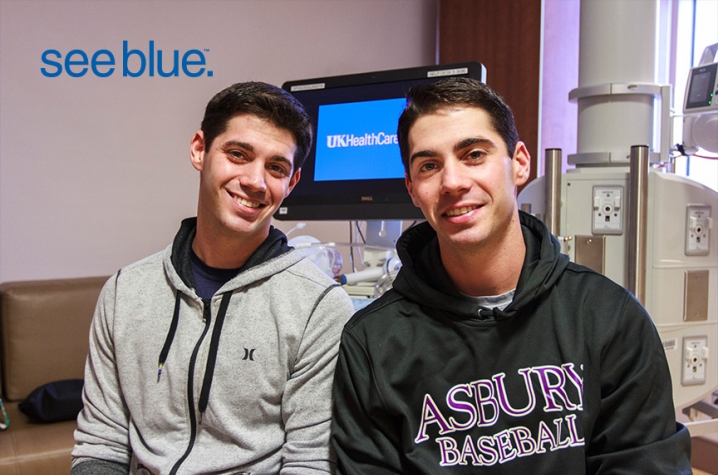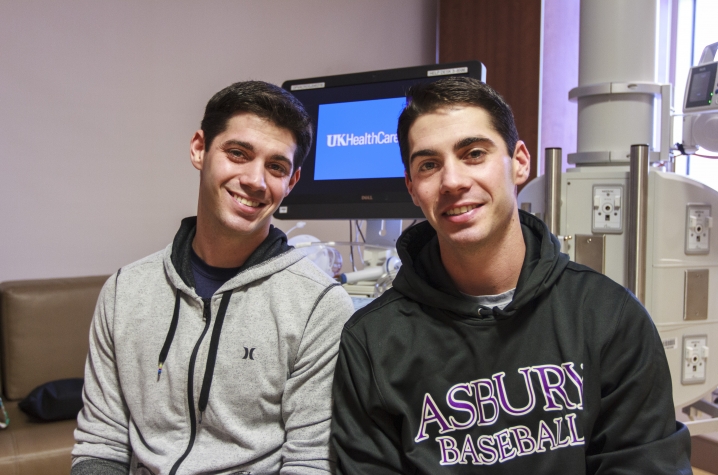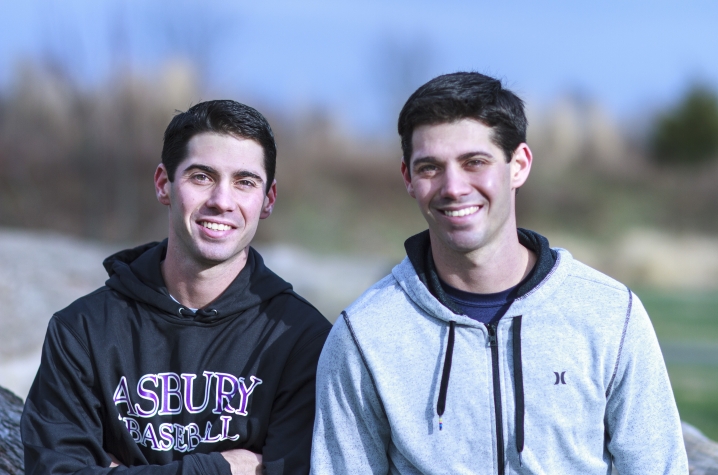Double Play: Gill Heart Institute Saves 27 Year-Old Identical Twins
LEXINGTON, Ky. (Oct. 19, 2015) — Jon Wes and Gardner Adams share a lot. Both have a profound love for baseball. Both are in phenomenal physical condition. And as identical twins, they share the same genetic profile.
The Adams twins, now 27, began playing baseball almost before they could read. Both were offered scholarships to Asbury University. Gardner was drafted by the Braves. Their work ethic was a big factor in their success on the diamond, running 25-30 miles a week, regardless of weather, each pushing the other to achieve.
It was that closeness — and their shared genes — that ultimately saved both their lives.
In June 2014, as Jon Wes was running in the Lexington Arboretum, his heart suddenly stopped beating. He collapsed near a concert, and audience members performed CPR for almost 20 minutes until emergency crews arrived to transport him to UK HealthCare. Doctors there told his frantic family that Jon Wes had about a 30 percent chance of survival.
But Jon Wes is a fighter. After several days in a medically induced coma, he began to wake up. Now the real work fell to Gill Heart Institute cardiologists Dr. Samy-Claude Elayi and Dr. Alison Bailey, who needed to figure out why a physically fit 26-year old would have sudden cardiac death. And after some sleuthing, they had their answer: Brugada Syndrome.
According to Elayi, Brugada is a fairly rare diagnosis, affecting only about one in 1,000 people, typically of Asian descent. It can cause dangerous arrhythmias, or abnormal heart rhythms, which in extreme cases can cause sudden cardiac death.
"Brugada Syndrome can sometimes be difficult to diagnose with ECG," said Elayi. "It took several tests, including genetic testing, to make the diagnosis." An implantable defibrillator — a tiny version of the paddles that doctors use to shock people back to life in medical television dramas — monitors arrhythmias and delivers a shock to the heart whenever one occurs. Jon Wes was implanted with an ICD in late June and was cleared to resume exercising shortly afterward.
In the meantime, Drs. Elayi and Bailey took note that Jon Wes had a twin — an identical twin. Gardner was put through the same paces. While the ECG was inconclusive for Brugada, the genetic tests indicated he had Brugada as well.
"We were now in uncertain territory, since there was no established protocol for implanting an ICD in anticipation of a cardiac arrest in patients without obvious Brugada on ECG and no prior abnormal heart rhythm," said Elayi.
And, Elayi explained further, ICDs aren't without risk. The longer a patient has an ICD, the greater their accumulated risk of infection, and Jon Wes is a young man.
"In the end, we had to make an educated guess about what to do," Elayi said. "We thought well, their genes are identical, so we ought to do it."
Gardner and his family agreed with the Gill team's recommendation, and on Aug. 29, 2014 — six days after his 26th birthday — Gardner was implanted with an ICD. His first words out of surgery: "Look Mom, we're identical again."
Fourteen months after Jon Wes collapsed, and almost exactly a year after Gardner received his ICD, a short run revealed just how sound that decision was.
Gardner and his wife, Mary Ann, went to a local park in Anderson County, where they now live, to get some exercise and fresh air. Elayi had warned the twins never to run alone, so the plan was for Gardner to run one direction around the circle while Mary Ann walked in the opposite direction. Just four minutes in, however, Gardner knew something was very wrong.
"I was dizzy and short of breath," Gardner said. "The next thing I knew, I woke up face down on the pavement."
Within a minute Mary Ann appeared on the path and immediately drove him to UK Chandler Hospital. There they learned the incredible news: during Gardner's run, his heart had stopped. The ICD had shocked his heart back to life.
"I could be in the ground somewhere," Gardner said. "I'm just very thankful for UK and for Dr. Elayi and Dr. Bailey, who spent a lot of time looking into the situation and made the call to give me an ICD."
In addition to helping one another, the twins are helping others. Their father, also named Wes, has the identical gene profile, and their younger brother Dean has some of the same genes. The genetic information from all four men will go to a biobank at Stanford University that collects data about Brugada, helping scientists around the world increase knowledge about Brugada, its origins, and potential cures. Meanwhile, Elayi is working with basic scientists at UK to get a better understanding of the specifics of Brugada in this family.
"Their genetic data can be a significant contribution to the study of Brugada," said Elayi.
The twins aren't content with that alone. Both have also become advocates for CPR, lobbying enthusiastically for the passage of a state law requiring CPR training as a mandatory requirement for high school graduation.
"If those people hadn't known CPR, I would almost certainly not be alive," said Jon Wes. "This experience has really made me rethink my life priorities, and getting others to recognize the importance of learning CPR is now at the top of the list."
Media Contact: Laura Dawahare, UK Public Relations, (859) 257-5307







